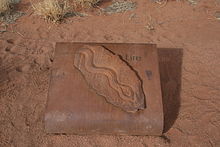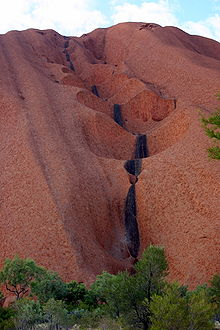Uluru myth


The Uluṟu myth is a myth of the Aboriginal dream time . He connects the holy mountain of the Australian natives with elements of a creation story .
At the beginning of the dream time, the rock did not exist in the imagination of the Aborigines in its present form. Some of the dream time stories are tens of thousands of years old. The Uluṟufelsen is divided into two mythical halves, the sunrise side (Djindalagul) and the sunset side (Wumbuluru). The myth explains the shape and formation of the Uluṟu, in particular the Mutitjilda Gorge, in which the most important dreamtime figure of the Aborigines lives with the rainbow snake Wanambi . Other stories tell, for example, of the struggle of the Liru (poisonous snake people) and the Kunia (carpet snake people).
The dreamtime stories
Wiya Kutjara (The Two Boys)
Two boys played in the mud after it rained and built uluṟu from the mud. They then traveled to the Musgrave Ranges in the south, where they hunted and ate a mountain kangaroo in Wiputa . Their next stop was Atila ( Mount Conner ), where their bodies in the form of rocks have been preserved to this day.
The mala
The land of today's Uluṟu was then flat; there was the Uluṟu waterhole and the Mututjilda spring where the Wanambi people lived. On the sunny side the mala , the rabbit kangaroo people, and on the dark side the kunia , the carpet snake people, lived in harmony and peace.
In the distance lived the Windulka , the Mulgasamen people. They intended to hold an initiation ceremony with their young people and invited their neighbors through Panpanpanala , the bell bird that flew to both tribes. The mala canceled because they wanted to conduct initiations themselves. The Kunia gladly accepted and traveled there. They came to the Uluṟu waterhole to spend the night there. There they met the Sleepy Lizard Women , called Sleepy Lizard Women (Lizard = blauzüngige Tiliqua rugosa ). They fell in love with her and stopped traveling. Instead, they settled at the source. The mulgasamen people waited for the mala and the kunia and sent the bell bird out to ask why they weren't coming to their event. The Kunia said they wanted to settle now and the Mala stressed that they were preparing their own ceremonies of initiation. The Mulgasamen people were upset and wanted to punish both of them.
The Mulgasamen people created a devilish dingo to punish the two tribes and a Kulpunya , a dog with huge teeth and without hair, was more vicious than a crocodile. The devil dog reached the uluṟu when everyone was nap and killed many of the mala , although Lorin , the kingfisher woman who had stayed awake, warned them. He drove the survivors from the Uluṟu and their symbol Kedrun , the eagle cub, became a symbol of mortality.
The Kunia
The Mulgasamen men also wanted to punish the Kunia and commissioned Liru , the venomous snake people and other fighters who lived at Kata Tjuṯa . Under the leader Kulikitjiri , they fought against the Kunia , who were led by Ungata . At the height of the battle, Bulari Minma gave birth to a child in a cave. Kulikitjeri was seriously injured in the fight, as was Ungata from Kulikitjeri's spear . Kulikitjeri died and the Kunia withdrew to the east. Ingridi , Ungata's mother, spat the mythical substance arukwita onto her weapon, a digging stick that became invisible. She knocked off Ungata 's nose with this weapon, and he died too. This death gave the Kunia courage and they came back to keep fighting. One of the Liru men set a fire in the Sleepy Lizard women’s village and the fight was over. The Kunia were so touched by the death of their leader that they sang themselves to death.
The entire incident, the fight, the suicides and the fire caused such massive movement in the interior of the earth that it combined with the ashes of the camp and highlighted the Uluṟu. With that the spirit of the Mala and Kunia has turned to stone.
Tjati
In another story, Tjati , a red lizard, travels to Uluṟu at the time of its formation and throws his throwing stick, which got stuck on the north side of Uluṟu. When Tjati tried to get his throwing stick back, it left a series of holes. Tjati couldn't reach his gun and died. Its remains are the large rocks at the bottom of the holes. Tjati is the name of the red lizard in Yakuntjatjara; in Pitjantjatjara his name is Lingka .
The emu meal
The Bellbird brothers stalked an emu, but the frightened animal ran north to the Uluṟu. Two blue-tongued lizard men, Mita and Lungkata , killed it and cut it apart with a stone ax. Large pieces of meat from him can be found on the southeast side of Uluṟu as fragments of sandstone slabs. When the Glockenvogel brothers arrived, the lizards only handed them a small piece of the emus, claiming that there was nothing more. In revenge, the Bell Bird brothers set fire to the lizards' shelter. The men tried to escape by climbing the rock face, but fell and burned. The gray lichen on the rock face is the smoke of the fire, and the lizard men are two boulders half-buried in the ground.
Interpretation at Uluṟu
According to the Aborigines, the mystical cycle is imprinted in the rock of Uluṟu - recognizable to them. In the Mutijilda Gorge, the features of the battle of Liru and Kunia are topographically formed. To the rock holes high up on Uluru bled Ungata . The rainwater that fills the water holes and flows through the gorge is Ungata's blood. On the rocky slope, areas are particularly strongly colored red by hematite . Ingridi used this red to paint her body as a sign of her sadness. The white spots are interpreted as the mythical substance arukwita , which made Ingridi's weapon invisible. The split nose lies as a rock in the ravine. On the eastern side three columns represent the wounds that Ungata Kulikitjeri inflicted. A cave nearby forms the lap of the Bulari Minma (Minma = mother), who was born here and the child lies in the form of a rock in front of the cave.
Research history
The dreamtime stories about Uluṟu were written down by three scientists. CP Mountford and WE Harney give more detailed descriptions, although they are said to have made some mistakes. Theodore George Henry Strehlow , anthropologist of German descent from Hermannsburg , was probably able to produce more correct descriptions, since he grew up with the Arrernte himself , but left a lot out, probably because the information according to Aboriginal law was only available to a certain group of people - for example initiated men - allowed to be accessible.
Parallels
The story of the mala, who lived on the sunny side, is related to the Bible in the expulsion from paradise. The fighting all took place on the shadowy side of Uluṟu. The mala, who lived carefree on the sunny side, were driven out of paradise and sent to them the devilish dog, the Kulpunya, who embodies the evil in the world.
The parallels to the Trojan War in Greek mythology can be seen. The fight of Hector against Achilles is comparable to the fight of Ungata and Kulikijeri. Ingridi's revenge is like the pain of Hecuba over the death of her son Hector.
literature
- James Cowan (2004): Dreamtime Revelations. The Aboriginal Spiritual Knowledge . Stuttgart: Lüchow-Verlag. ISBN 3-363-03050-9
- Robert Layton (1989) Uluru - An Aboriginal History of Ayers Rock ISBN 0855752025
